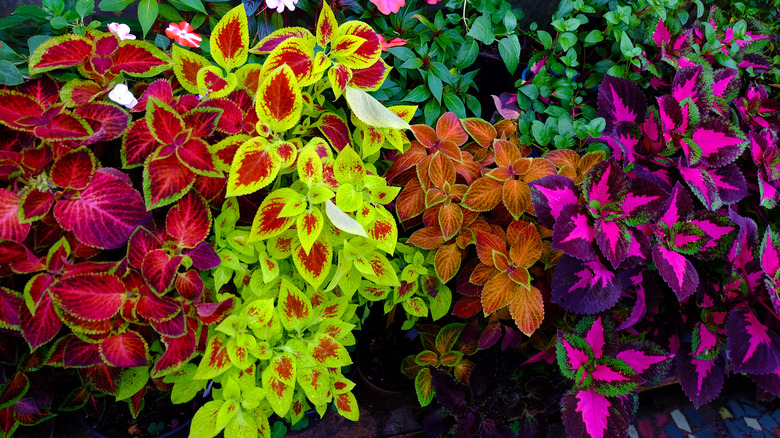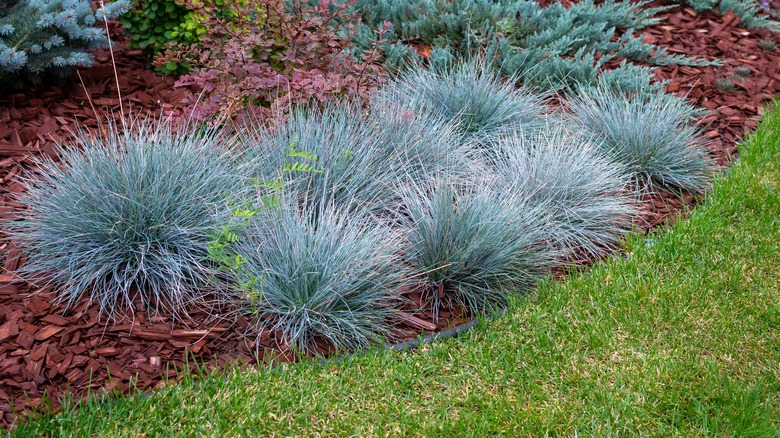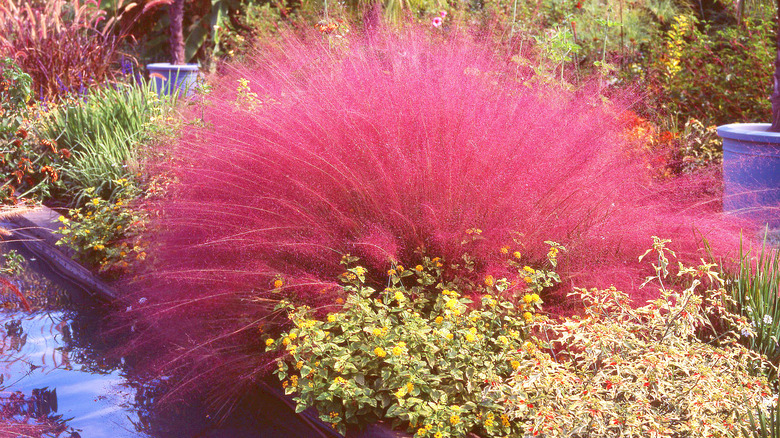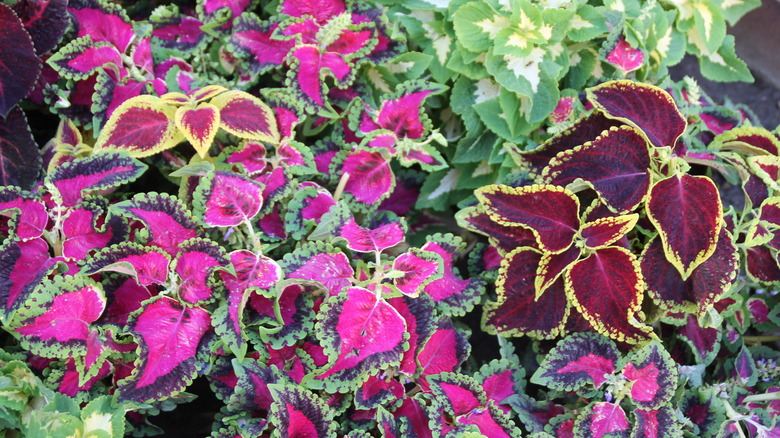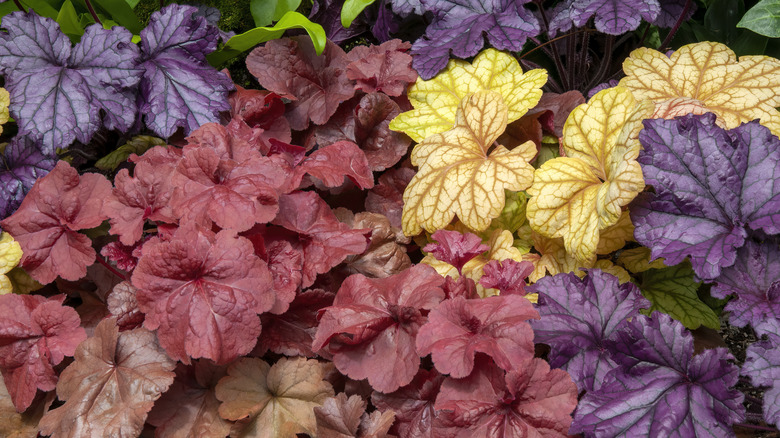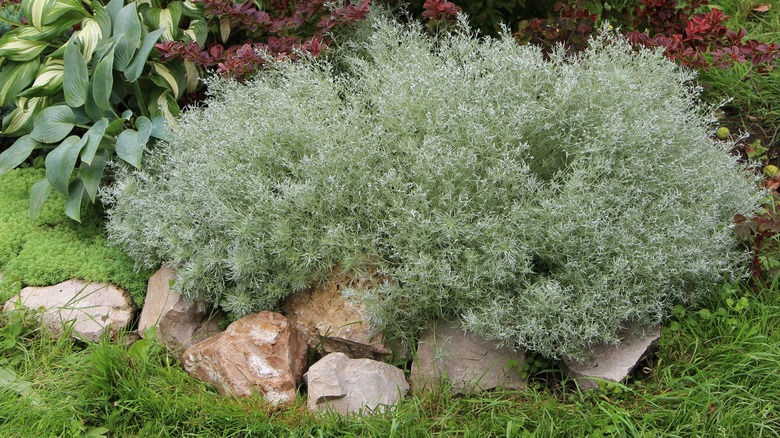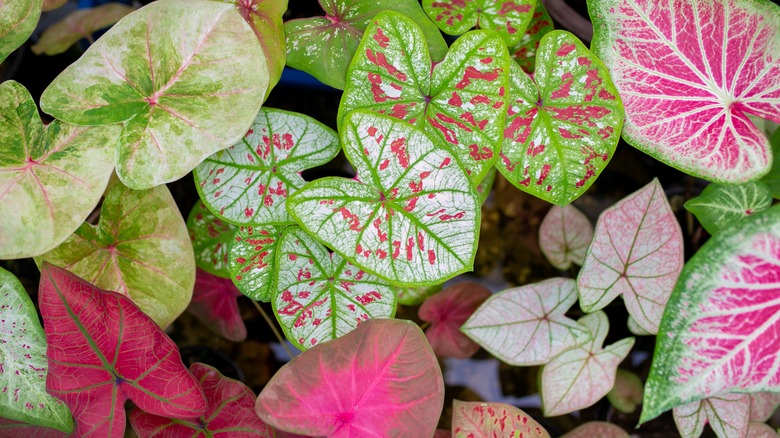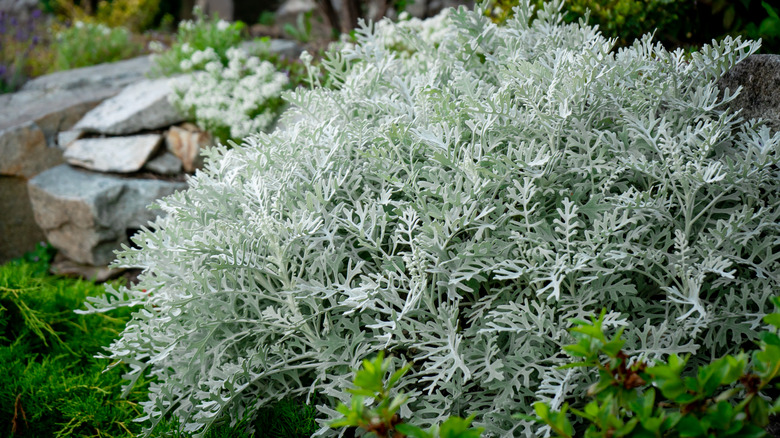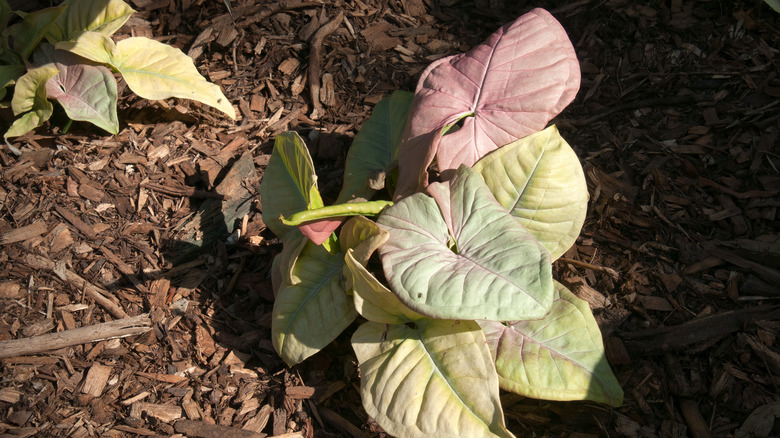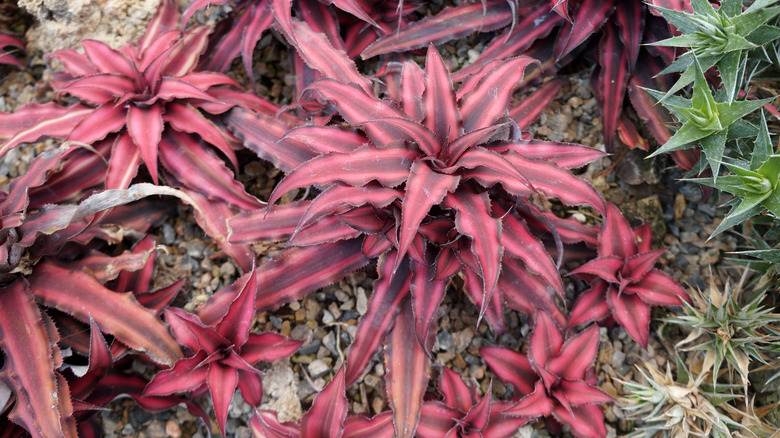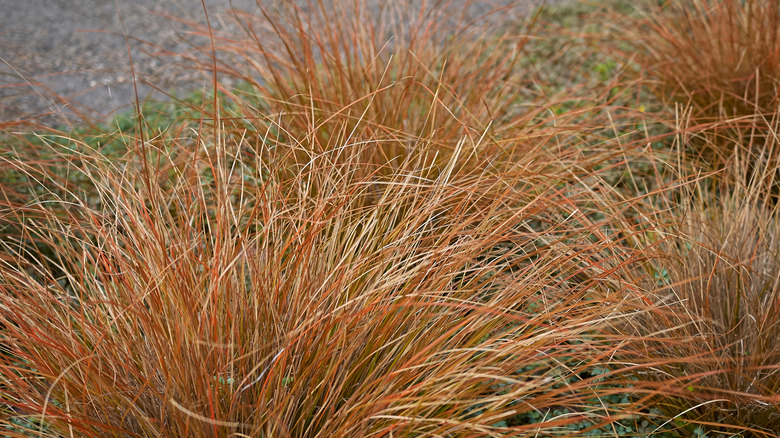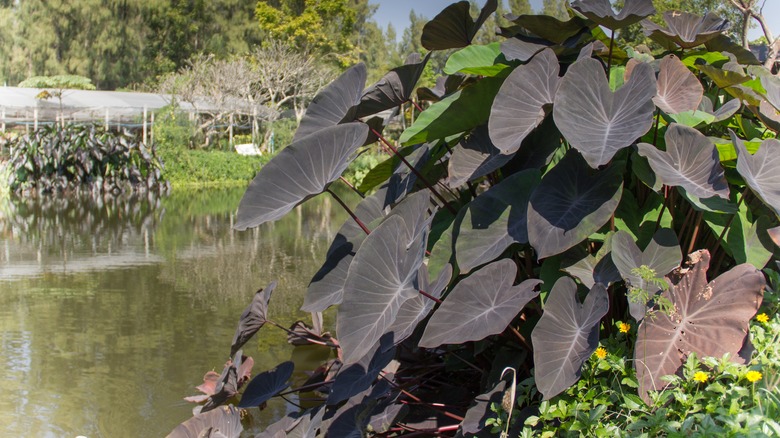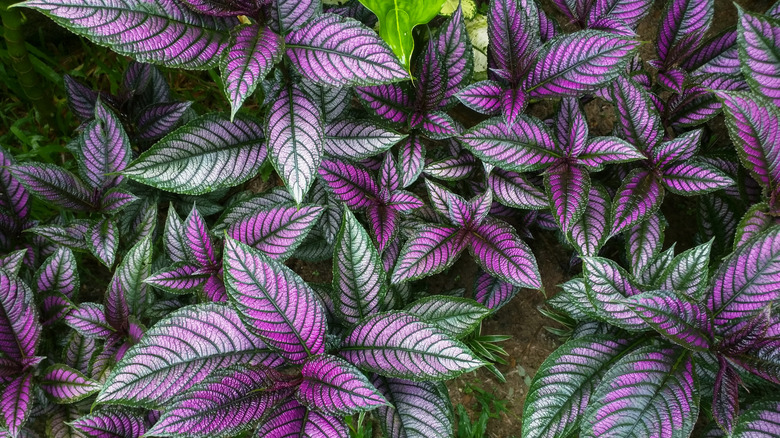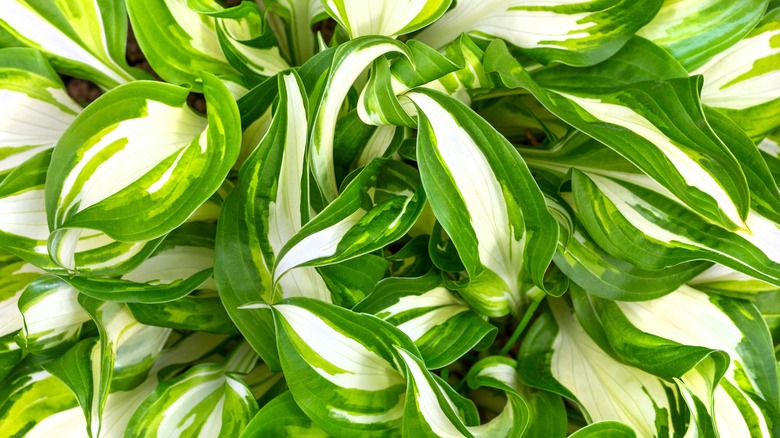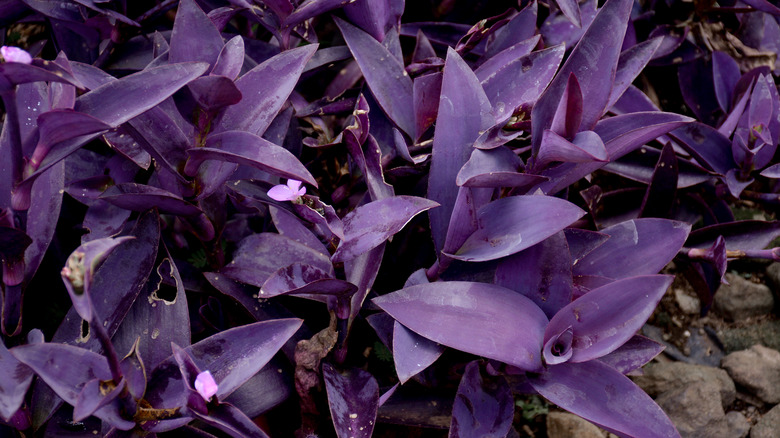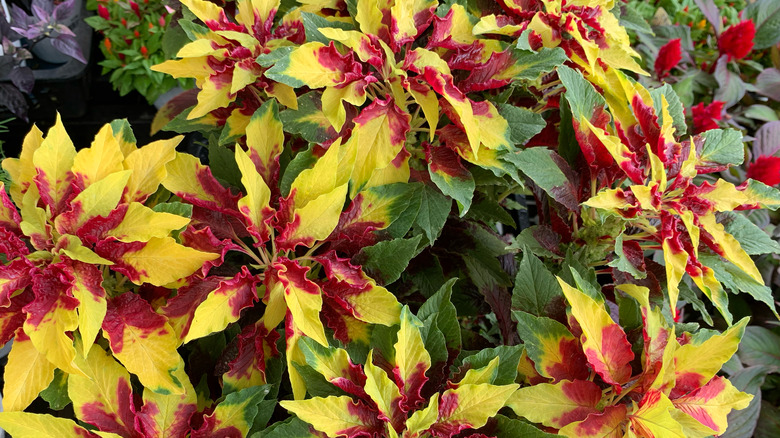Colorful Plants To Grow In Your Garden That Aren't Flowers
When you think of a colorful garden, yellow daises or pink tulips might come to mind, but what about grass and shrubs? These plants are synonymous with greenery, but they are far from monochrome, as the name implies. Flowers aren't the only choice for your garden to have a taste of the rainbow, and many might not want the blossom in their lawn, whether due to allergies or the insects they attract. Fortunately, there are ornamental grasses and bright foliage that will add color to your yard without a petal in sight.
From dark purples to creamy whites, there is a myriad of plants ideal for your garden, regardless of whether you're looking for subtle color or want your grounds to be the brightest on the block. You don't need to be an experienced gardener to plant any of these chromatic shrubs, either. Feel free to mix and match to perfectly curate your outdoor space.
Blue fescue
Bluegrass isn't just a music genre. Festuca glauca, commonly known as blue fescue, is an ornamental grass that grows in a cool color. This low-growing plant needs full sun and well-drained soil for its rich hue to shine. It can still survive in drought, dry soil, and partial shade, but it won't be as stunning. Blue fescue is hardy in USDA zones 4 to 8 and is perfect to add to your garden for vibrant ground cover or to line your walkway.
Pink muhly
If blue isn't your color, how about pink? Muhlenbergia capillaris is pink ornamental grass and a definite eye-catcher for your garden. Not only is pink muhly beautiful but it's low-maintenance too. The foliage stands up to poor soil, heat, humidity, and drought. It grows best in zones 5 to 9 in full sun and moist soil. Planting this grass in your yard can also attract butterflies and songbirds to your home. Pink muhly is ideal as a border plant or a pop of color among greens.
Coleus
Coleus scutellarioides, or simply coleus, is known for its colorful leaves. You can spot yellow, pink, red, and purple in its foliage. Partial sun and well-drained soil are key for your coleus plant to thrive. Some varieties will bleach in aggressive sunlight, causing their vibrant colors to fade. Excess water can damage the plant, resulting in brown leaves. The coleus is only recommended for USDA hardiness zones 10 and 11. However, if they won't survive in your garden bed, this vivid plant can be grown in containers.
Coral bells
Coral bells (Heuchera) have foliage that comes in a wide range of shapes, sizes, and colors. With the right growing conditions, it can sprout pink, copper, blue, purple, and even multicolored leaves. This perennial groundcover is hardy in zones 3 to 9 and prefers full sun, dry air, and moist soil. Coral bells will persevere in shady areas, but at least six hours of direct sunlight is needed for vibrant foliage. Use it to decorate around patios and ponds or even in your rock garden.
Absinth
For a subtle pop of color, absinth, scientifically known as Artemisia, is a stellar choice. Its leaves are silver-gray, adding a nice shimmer to your lawn. Along with the enticing shade, the silver foliage is aromatic, making it perfect for borders and potpourri. Absinth is easy to grow, deer-resistant, and drought-tolerant. However, constantly wet soil is its kryptonite. Up to eight hours of sunlight and well-drained soil will serve this shrub best. It is recommended for USDA zones 3 to 8.
Angel wings
Angel wings (Caladium bicolor) have unique arrowhead-shaped leaves that bring white, pink, and red to the party. The heart and veins of each leaf are packed with color, while the border is green. The ornamental foliage is only hardy in zones 9 and 10, but it could also be grown as a statement houseplant. Angel wings drink a lot of water and prefer moist soil. Partial shade or even full shade is best. However, this pretty plant is toxic to cats and dogs if consumed, so be mindful if you have pets.
Dusty miller
Jacobaea maritima, or dusty miller, has a lovely silver hue. The velvety soft foliage appears sprinkled with snow, which makes for a distinct shrub that isn't too showy. Dusty millers are drought tolerant, so don't fear if you miss a watering or two. They also survive in shade or with no direct light. However, the sun brings out the finest hues of silver. It is hardy in USDA zones 7 to 10 and prefers well-drained soil.
Arrowhead
There are many types of arrowhead plants, but the one known as Syngonium podophyllum 'Neon Robusta' has rosy pink leaves that make it a show stopper. The light green foliage fades into pink and will fare well with other greenery. It is hardy in zones 9 to 11, where sunlight is key, but preferably keep your arrowhead out of harsh direct sunlight. It also likes lightly moist soil and humidity. This pink plant is not safe for pets to consume, so keep it away from your curious four-legged friends.
Earth star
Cryptanthus bivittatus has the fitting common name earth star, as its striped pink leaves sprout in the celestial formation. Each plant produces between 10 and 20 of its glamorous leaves, so you might want a few for your garden. Rich, well-drained soil and partial shade will have your earth star looking its best. Too much sunlight and the leaves shrivel, while not enough sunlight means they won't achieve that striking pink shade. USDA zones 8 to 11 have the hardy ground for this drought-resistant plant.
Leatherleaf sedge
Leatherleaf sedge (Carex buchananii) is a USDA zone 6 to 9 plant. This ornamental grass grows copper-bronze leaves for an autumnal touch to your spring garden. It needs partial to full sun, moist soil, and rich organic matter to thrive. Leatherleaf sedge is a low-maintenance crop, so you don't need a green thumb for the shiny brown blades to flourish. You can plant it near silver foliage like dusty miller or absinth for a muted yet colorful lawn or go all out by pairing it with blue and pink grasses.
Elephant ears
Elephant ears (Colocasia esculenta) have huge leaves, and the 'Black Magic' variety takes the grand foliage to another level with its rich purple pigment. It is stellar for adding dark contrast to bright plants without settling for the typical green. Full sun is needed to bring the deepest hue out of your elephant ears but it does best when shaded from harsh afternoon light. Your purple-black plant will thrive in zones 8 to 10, with moist, organic-rich soil.
Persian shield
Strobilanthes dyerianus, commonly known as the Persian shield, is another purple plant ready to add color to your garden. The green leaves have a violet center and silver overlay. The Persian shield is only hardy in a few zones — 10 and 11 — but you can enjoy the purple tinge as a houseplant, too. This evergreen shrub needs lots of water, rich soil, and full sun. It doesn't mind wet soil, but you don't want to overwater it and cause the roots to rot.
Hosta
Hostas are popular perennials because of their showy leaves, and the Undulata Variegata variety is a great choice for subtle color. The leaves have a creamy white center and green outline for bright two-tone foliage. USDA zones 3 to 8 will have the best chances of growing these hostas. Give the Undulata Variegata hosta part shade, rich soil, and even moisture. The plant will also thrive in full shade, just don't let its soil completely dry out.
Purple heart
Purple heart (Tradescantia pallida) is an evergreen perennial hardy in zones 7 to 11. Its dark violet leaves sprout 7 inches long, perfect for ornamental ground cover in your garden. Purple hearts are low-maintenance, drought-resistant, and don't mind being ignored. With full sun and moist soil, your perennial should thrive. A stunning pink flower also blooms from the violet leaves in the summertime, but feel free to trim the blooms to keep eyes focused on the colorful foliage.
Joseph's coat
Amaranthus tricolor, aka Joseph's coat, has three colors in its leaves. The ombré of red, yellow, and green is a vibrant pop ideal for borders and garden beds. Those in USDA zones 2 to 11 have the pleasure of growing this beauty. Moist soil and part shade are best for this multi-color plant. It stands up to droughts, heat, and poor soil, making it a great option for beginner gardeners and professionals alike. With all the options these rainbow-like plants offer, try using the color wheel to design the perfect vibrant garden.
